Rainbow Six: Vegas: A Performance Analysis
by Josh Venning on December 25, 2006 6:00 AM EST- Posted in
- Gaming
Graphics Settings
Rainbow Six: Vegas as we mentioned came with a lot fewer bugs and less clunkiness in the interface than the previous Splinter Cell: Double Agent we reviewed. We didn't experience any of the crashing problems with certain hardware when changing settings and we didn't have to restart the game constantly to get some settings to change. Also, loading and exiting a game to the menu took much less time which made our testing much easier - something we were very thankful for after our negative experience with the Double Agent interface.
The graphics quality settings for Vegas are a lot more straightforward than with Double Agent as well, while still offering control over a few basic settings. Some gamers might have liked more control over specific graphics options, but unfortunately they are out of luck. Still, some control is better than none, and here are the options we have available.
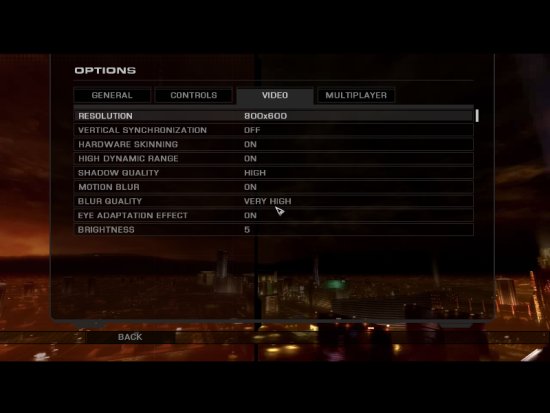
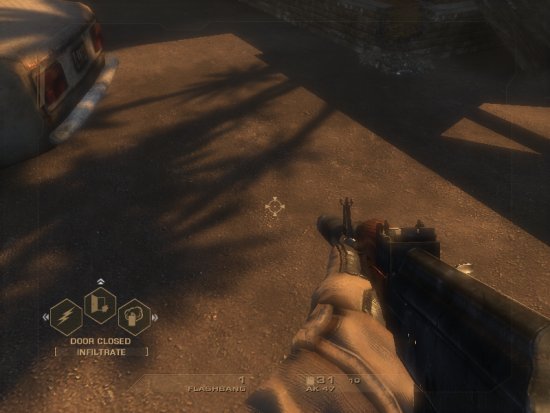
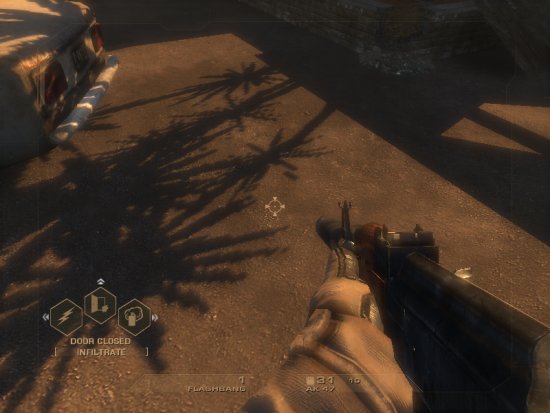
As with Double Agent, we tested Rainbow Six: Vegas at two different quality settings: one with the graphics settings at their highest, and one at lower quality settings for the lower-end cards. We only tested lower-end and midrange cards at the low quality settings, as they were the only ones that could really benefit from the extra performance. Also, the highest resolution available in the game menu is 1600x1200, but even for those with displays capable of higher resolutions, running Vegas smoothly at this resolution with the settings on highest quality will need a powerful graphics solution - something more along the lines of an 8800 rather than a 7900 GTX or X1950 XTX.
When testing at the highest quality settings, each setting was turned "on" or to the highest option available. Conversely, with the lower quality settings, we turned everything to "off" or to their lowest setting, with the exception of hardware skinning. We found this setting didn't cause much of a performance hit on our benchmark when enabled, so we left it on for all the tests. (Note that this might not be the case in other parts of the game where there are lots of characters in the scene, and turning hardware skinning off is suggested to improve gameplay performance if necessary.)
We found that with Rainbow Six: Vegas, there wasn't as much of a performance gain as we would have liked with all of the quality settings at their lowest, but we also didn't notice much difference with the settings all off, aside from the most obvious shadow effects. The game is still enjoyable with the lower quality settings, and even at a resolution of 800x600 it still looks good. The lack of an in-game option for selecting widescreen resolutions is unfortunate, but luckily some enterprising souls have created a hack available at the WSGF for the interested.
The Benchmark
Our benchmark was suggested to us by Ubisoft and it's basically an average FPS of looking out of the window on the first helicopter ride over a cityscape in Mexico. The game has no quicksave or save options, only a checkpoint system that lets you load a checkpoint as you progress in the game. There was no timedemo function to record a demo so we used FRAPS to benchmark the game. This is unfortunate because it means we can't test how the game performs during firefights, which are more graphically intensive than the helicopter ride. We can get a general idea of overall game performance, however, taking into account our benchmark results.
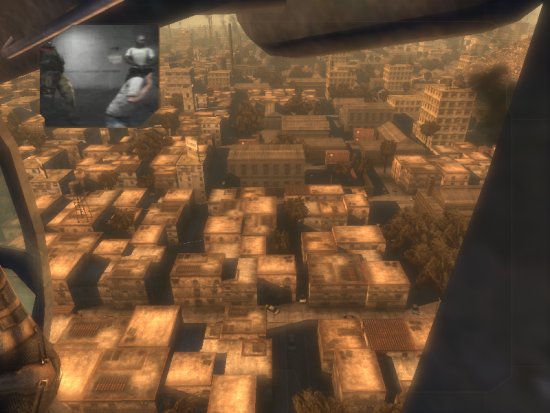
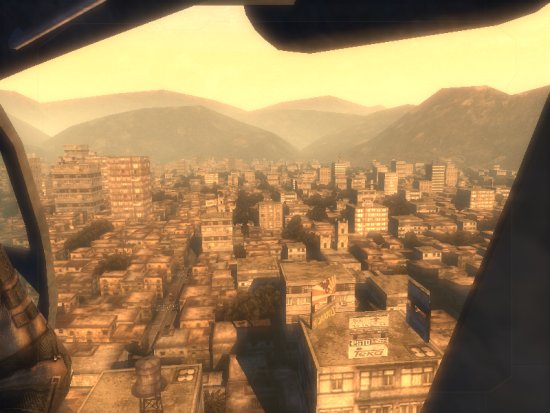
The cityscape in this first helicopter ride is impressive, with individual buildings stretching far to the horizon and large mountains looming over them in the distance. Smoke billows out of smokestacks, and some skyscrapers jut out higher than the others, while the helicopter's shadow is cast realistically further and closer on the buildings as you approach the drop-off point.
Because there aren't really any characters in the scene we used for our benchmark, the frame rate we will see in our tests will be a little higher than what we would expect during much of the gameplay of RSV. You can expect performance to decrease by as much as 30% or more with multiple enemies and your teammates all fighting in a scene. This makes things difficult as the action in the game can be very fast paced, and finding a target and hitting him accurately and quickly is sometimes vital to your survival.
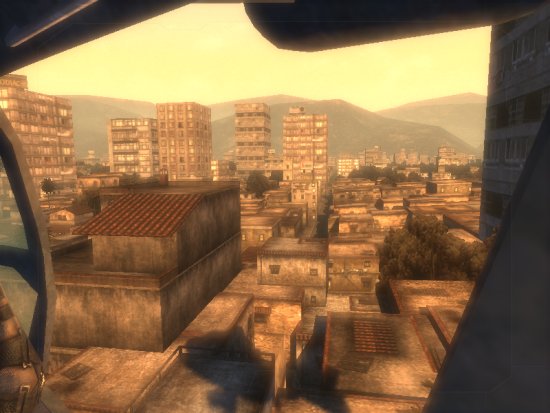
Rainbow Six: Vegas as we mentioned came with a lot fewer bugs and less clunkiness in the interface than the previous Splinter Cell: Double Agent we reviewed. We didn't experience any of the crashing problems with certain hardware when changing settings and we didn't have to restart the game constantly to get some settings to change. Also, loading and exiting a game to the menu took much less time which made our testing much easier - something we were very thankful for after our negative experience with the Double Agent interface.
The graphics quality settings for Vegas are a lot more straightforward than with Double Agent as well, while still offering control over a few basic settings. Some gamers might have liked more control over specific graphics options, but unfortunately they are out of luck. Still, some control is better than none, and here are the options we have available.

- Hardware Skinning: on/off
- High Dynamic Range: on/off
- Shadow Quality: very low/high
- Motion Blur: on/off
- Blur Quality: very low/very high
- Eye Adaptation Effect: on/off


As with Double Agent, we tested Rainbow Six: Vegas at two different quality settings: one with the graphics settings at their highest, and one at lower quality settings for the lower-end cards. We only tested lower-end and midrange cards at the low quality settings, as they were the only ones that could really benefit from the extra performance. Also, the highest resolution available in the game menu is 1600x1200, but even for those with displays capable of higher resolutions, running Vegas smoothly at this resolution with the settings on highest quality will need a powerful graphics solution - something more along the lines of an 8800 rather than a 7900 GTX or X1950 XTX.
When testing at the highest quality settings, each setting was turned "on" or to the highest option available. Conversely, with the lower quality settings, we turned everything to "off" or to their lowest setting, with the exception of hardware skinning. We found this setting didn't cause much of a performance hit on our benchmark when enabled, so we left it on for all the tests. (Note that this might not be the case in other parts of the game where there are lots of characters in the scene, and turning hardware skinning off is suggested to improve gameplay performance if necessary.)
We found that with Rainbow Six: Vegas, there wasn't as much of a performance gain as we would have liked with all of the quality settings at their lowest, but we also didn't notice much difference with the settings all off, aside from the most obvious shadow effects. The game is still enjoyable with the lower quality settings, and even at a resolution of 800x600 it still looks good. The lack of an in-game option for selecting widescreen resolutions is unfortunate, but luckily some enterprising souls have created a hack available at the WSGF for the interested.
The Benchmark
Our benchmark was suggested to us by Ubisoft and it's basically an average FPS of looking out of the window on the first helicopter ride over a cityscape in Mexico. The game has no quicksave or save options, only a checkpoint system that lets you load a checkpoint as you progress in the game. There was no timedemo function to record a demo so we used FRAPS to benchmark the game. This is unfortunate because it means we can't test how the game performs during firefights, which are more graphically intensive than the helicopter ride. We can get a general idea of overall game performance, however, taking into account our benchmark results.


The cityscape in this first helicopter ride is impressive, with individual buildings stretching far to the horizon and large mountains looming over them in the distance. Smoke billows out of smokestacks, and some skyscrapers jut out higher than the others, while the helicopter's shadow is cast realistically further and closer on the buildings as you approach the drop-off point.
Because there aren't really any characters in the scene we used for our benchmark, the frame rate we will see in our tests will be a little higher than what we would expect during much of the gameplay of RSV. You can expect performance to decrease by as much as 30% or more with multiple enemies and your teammates all fighting in a scene. This makes things difficult as the action in the game can be very fast paced, and finding a target and hitting him accurately and quickly is sometimes vital to your survival.











32 Comments
View All Comments
ariafrost - Monday, December 25, 2006 - link
Well forget about running it on my X850XT, apparently RSV *requires* a Pixel Shader 3.0 video card. If anyone could confirm/deny that information it'd be great, but for now it looks like a lot of ill-informed customers may end up buying a game their "128MB/256MB" video cards can't support.justly - Monday, December 25, 2006 - link
Anandtech always seems to have a problem when ever it can't recomend NVIDIA as the best solution in every senerio. What is so wrong with the idea that ATI hardware performs better than NVIDIA hardware of the same generation? Maybe I'm mistaken, but I thought even Anandtech expected ATI might do better in newer games.
Personally I'm not much of a gamer so it really doesn't matter to me, but fot the sake of the people using your articles to choose hardware why give them expectations that might not materialize?
Maybe because I am not engrosed in the gamming experiance I have a different perspective, but considering a lot of games are ported over from consoles (or at least designed with consoles in mind) wouldn't it be reasonable to expect any game designed around a console using ATI graphics to favor ATI graphics on the PC? It wouldn't surprize me in the least to see games favoring (or at least more competitive) on hardware built around ATI for the next year or two.
Jodiuh - Monday, December 25, 2006 - link
Because it's happened before. Remember Oblivion?munky - Monday, December 25, 2006 - link
Nothing happened. The 7-series still has much worse performance in Oblivion in outdoor scenes with foliage than equivalent Ati cards.http://www.firingsquad.com/hardware/nvidia_geforce...">http://www.firingsquad.com/hardware/nvidia_geforce...
Frumious1 - Monday, December 25, 2006 - link
Try not to be so easily offended, Justly. I think the point Anandtech was trying to make is that they hope the performance gap can be reduced somewhat with driver/game updates. There are other games where NVIDIA outperforms ATI, but overall the 7900 GTX offers similar performance to the X1900 XT and not too much worse than the X1950 XT/XTX cards (I think). Another way of looking at this is that perhaps they just hope SM3 support doesn't turn into a GeForce FX fiasco again.So far, looks to me like ATI has better shader hardware. Ever read any of the stuff on the folding at home forums by their programmers? Basically, they have stated that G70 really has poor performance on their SM3 code even with optimizations... and it doesn't even look like G80 will be all that great. All that said, I still don't like ATI's drivers. CCC(P) is so sluggish it's pathetic, and that's after performance improvements since it first cam out.
jediknight - Monday, December 25, 2006 - link
I was hoping to see some of the last gen cards (err.. now with the 8800, I guess two gens old..) - as that's what I'm running with (with no hope of upgrading - as I'm with AGP right now.. )Specifically, if future reviews would consider the performance of the X800XL running at 1280x1024, I'll be happy :->
Spoelie - Monday, December 25, 2006 - link
you need to have a SM3 card to play this game, as such, it won't even start on your card.not that I agree with that policy, they should have provided a SM2 path, not everybody has a ~1/1.5 years old card.
jkostans - Monday, December 25, 2006 - link
I think its pretty clear you'll be needing to run at 800x600 with med graphics, or 1024x768 with low graphics settings in order to get around 20 fps.Tanclearas - Monday, December 25, 2006 - link
At 1600 x 1200, the 7900GTX runs at 19.8 and the X1950XTX runs at 20.4 FPS. Given those numbers, the above quote doesn't really make much sense. Did I miss something?
And just so people don't think I'm whining, or a fanboy, or whatever, I have an X1900XT (512MB). I am just honestly confused by the conclusion that the X1950XTX could handle 1600 x 1200 and the 7900GTX could not.
Josh Venning - Monday, December 25, 2006 - link
Thanks for the comment. The paragraph has been tweaked a little so that it's a little more clear. The fact is that both the X1950 XTX and 7900 GTX at reference speeds experience a little choppiness in the game at the highest resolution and quality settings. With some overclocking, either of these cards could run the game at these settings smoothly. Sorry for the confusion.